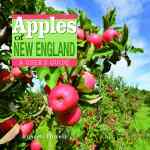
FEW APPLES are in as great demand every fall as Honeycrisp. This extraordinary apple combines several superlatives in one package, beginning with its uniquely crisp yellow flesh. Firm yet light, it bursts in your mouth with a texture reminiscent of watermelon.
There may not be a juicier apple.
Honeycrisp has outstanding flavor, sweet, but not too sweet. Unlike some of the sugary sweet varieties that have recently entered the market, with Honeycrisp the distinctive taste and aroma of apple comes through strong.

Honeycrisp are bluntly conical, sometimes, round, and come in a range of colors, from solid red to almost yellow. Most good Honeycrisp should have at least some red color, the more, the better.
Honeycrisp can grow exceptionally large. Individual apples can weigh well over a pound.
Honeycrisp is a relatively new variety, developed at the University of Minnesota in 1961, which may explain its success in New England’s similarly cold climate. Its parentage is Keepsake and an unknown seedling. It took 30 years for Honeycrisp to be released commercially in 1991.
Because of its immense popularity, growers everywhere are planting Honeycrisp today. But there are Honeycrisp and there are Honeycrisp. It can be a difficult apple to grow and ship.
Honeycrisp shipped into New England in winter and spring can partially satisfy a craving until the next fresh harvest, and many of them are good apples. But some of the Honeycrisp from elsewhere are bland and watery, lacking the apple’s characteristic juiciness, flavor, and snap, and having little red color.
New England grows some of the best Honeycrisp in the country, and most of them stay right here.
To make sure that you are getting the full, rich experience of the amazing Honeycrisp, your best bet is the locally grown New England apple.
*
THE ORIGINAL HONEYCRISP tree was nearly tossed away. It took DNA tests to ascertain its parentage. Honeycrisp’s success has had repercussions throughout the apple industry.
Read the fascinating history of Honeycrisp in “The race for the next Super Apple,” a chapter in America’s Apple, a book by Russell Steven Powell, senior writer, and Bar Lois Weeks, executive director of the New England Apple Association. The chapter looks at how apple breeders around the world are hard at work trying to develop a new variety that can match Honeycrisp’s stunning success, and explains why that is not so easy to do.
 America’s Apple (Brook Hollow Press) tells a rich and detailed story about apple growing in America, from horticulture to history to culinary uses. Powell writes about the best ways to eat, drink, and cook with apples. He describes the orchard’s beauty and introduces readers to some of the family farms where apples are grown today, many of them spanning generations.
America’s Apple (Brook Hollow Press) tells a rich and detailed story about apple growing in America, from horticulture to history to culinary uses. Powell writes about the best ways to eat, drink, and cook with apples. He describes the orchard’s beauty and introduces readers to some of the family farms where apples are grown today, many of them spanning generations.
America’s Apple looks at how America’s orchards are changing as a result of the trend toward intensive planting and the trademarking of new varieties, and what that means to consumers. Powell also writes about the fragile underpinnings of modern agriculture: the honeybees needed to pollinate the crop and the labor required to pick it, plus new and exotic pests and increasingly volatile weather.
 Powell and Weeks explore the history of apple growing in the region Apples of New England (Countryman Press), an indispensable resource for anyone searching for apples in New England orchards, farm stands, or grocery stores — or trying to identify an apple tree in their own backyard.
Powell and Weeks explore the history of apple growing in the region Apples of New England (Countryman Press), an indispensable resource for anyone searching for apples in New England orchards, farm stands, or grocery stores — or trying to identify an apple tree in their own backyard.
The book contains color photographs by Weeks and descriptions of more than 200 apples discovered, grown, or sold in New England, accompanied by notes about flavor and texture, history, ripening time, storage quality, and best use. Apples of New England offers practical advice about rare heirlooms and newly discovered apples.
Apples of New England includes chapters on the rich tradition of apple growing in New England, and on the “fathers” of American apples, Massachusetts natives John Chapman (“Johnny Appleseed”) and Henry David Thoreau. Apples of New England presents the apple in all its splendor: as a biological wonder, as a super food, as a work of art, and as a cultural icon.
Apples of New England and America’s Apple are available in hardcover at fine bookstores and orchards and online. America’s Apple is also available in paperback.